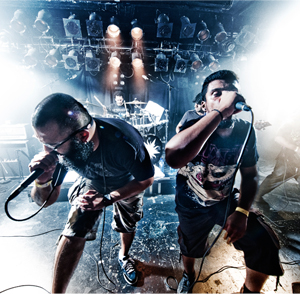 For years, a rebellious subculture had been taking shape in the midst of our repressive, conformist society. By the late 90s, there was a small, angry segment among the Indian youth that craved a sound that was louder, murkier and more demonic than the all-pervasive pop. With the rise of Indian metal, our land of religion and piety became home to a Satan-worshipping tribe sporting devil and skull motifs. This visceral and diabolical music drowned the collective, fractured sounds that were as rampant in India as garish posters advertising political parties. And so, the sonic misfits who craved edgier music began to find their own niche.
For years, a rebellious subculture had been taking shape in the midst of our repressive, conformist society. By the late 90s, there was a small, angry segment among the Indian youth that craved a sound that was louder, murkier and more demonic than the all-pervasive pop. With the rise of Indian metal, our land of religion and piety became home to a Satan-worshipping tribe sporting devil and skull motifs. This visceral and diabolical music drowned the collective, fractured sounds that were as rampant in India as garish posters advertising political parties. And so, the sonic misfits who craved edgier music began to find their own niche.
It was in 2008 that Canadian anthropologist and filmmaker Sam Dunn took images of the Indian metal scene to the world. In his documentary Global Metal, Dunn showed how metal had spread across the world beyond Europe and North America, and how in these new countries it was influenced and flavoured by the local culture, politics, and religion. Global Metal gave the world a first dekko at India’s metal uprising. An Indian metalhead captured on camera defended his choice thus: “I want my music to be strong. That’s why I relate to metal.”
In India, metal music became a sonic assault on organised religion, the effete political system, and ▶ the bane of corruption. You can now find growling salutations to Anna Hazare between two metal numbers, lyrics bemoaning the Bhopal gas tragedy, and a mention of Mahatma Gandhi’s teachings. Thankfully, the primary role is not social activism but music-making.
Tribal Revival
The movement in India broke out around 1997, inspired by international metal bands like Iron Maiden, Slayer, and Metallica. “The line between metal and hard rock was not so sharply defined back then,” says Ravi Balakrishnan, who has been following the Indian metal scene since its inception. “In the early and mid-90s, Indian rock emerged with a huge focus on bands recording original songs. Many of these songs were bad clones of famous ones. However, bands soon improved the quality of their music. Critics such as Amit Saigal of Rock Street Journal made it a matter of principle to push original music – good or bad. Since then, the journey has been inspiring and steady, starting from the first flush of bands playing covers to being reckoned as the metal voice of the world.
One either loves metal or hates it. It’s understandable how distorted guitar sounds and high-pitched vocals devoid of decipherable lyrics can turn some people off. To anyone who is not a metal fan, the scene is impenetrable and often remains a matter of derision. But if the prophesies of doom and apocalypse are (as some critics say) “imports from the West,” they are fooling themselves. Take Bruce Dickinson, vocalist of Iron Maiden, who on his first visit to India reminisced on the recurring theme of romanticised death and destruction in his new album Brighter than a Thousand Suns and its Oriental perspective. Bruce recalls the spine-tingling epiphany felt by Robert Oppenheimer – father of the atomic bomb’ – at what he had unleashed. Oppenheimer’s quote from the Gita was: “Now I am become Death, the destroyer of worlds.”
Local musical influences are apparent in the music produced by popular band Motherjane. Guitarist Baiju Dharmajan adds unique Carnatic guitar notes to their music. Rudra is a popular Vedic metal band, with lyrics that draw inspiration from the Mahabharata and the Upanishads. Many other bands in India and abroad have started producing songs with Vedic lyrics injected with Indian classical music. In addition, some bands compound ethnic/folk tunes with various metal genres to form a folk metal band.
Although the metal community in India started out strong, the movement would have dispersed and disintegrated if not for rock festivals that nurtured the scene. During such festivals, one can see a whole cadre of metal fans launching record labels, managing bands, starting blogs, and promoting and organising gigs. Festivals have become a one-stop destination where one can experience the fabulous wealth of both global and local sounds
Kickstarted in 1996, the Independence Rock Festival is a good place to catch some well-known metal bands and also newly emerging ones. Great Indian Rock, first held in 1995, gives Indian bands a chance to share the stage with international biggies. Rock in India is another Bangalore-based heavy metal festival. The venue has seen music makers such as Iron Maiden and Megadeth crushing skull on its turf as the crowd head-bobs in mosh pits and the music reaches heavier riffs.
But Indian metalheads don’t wait for festivals to tune in to their favourite bands; they Facebook their way to gigs all over the country. Headbanger’s Kitchen, a cooking show started in March 2011 by Demonstealer (Demonic Resurrection/ Workshop/ ReptilianDeath) and Srinivas Sunderrajan (Scribe) has been creating a buzz in the Indian metal community with mouthwatering recipes and plenty of metal talks featuring different bands. New media has allowed metalheads to unite across the globe. Underneath these fractious diasporas, however, metal lovers remain united and nurtured by the power of music.
The Independence Rock Festival, also called the ‘Woodstock of India’, is a good place to catch some well-known metal bands, and also newly emerging ones.
Volume 1 Issue 1




























